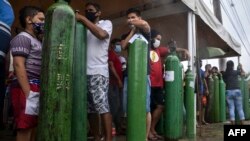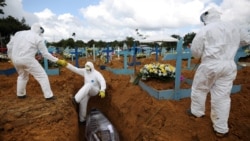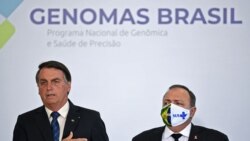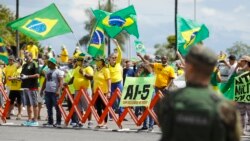On January 14, the health care system in Manaus, the capital of Brazil’s Amazonas state, broke down for a second time when overrun hospitals ran out of oxygen for COVID-19 patients. Medical workers and family members recounted horror scenes, including patients dying of asphyxiation despite desperate efforts by doctors.
The governments of President Jair Bolsonaro and Amazonas were blamed by the opposition, experts and some Brazilians. The crisis fueled a new impeachment request for Bolsonaro. Meanwhile, the Venezuelan government announced it was providing oxygen to mitigate the Manaus crisis.
On January 15, Bolsonaro defended his administration, saying, “We’ve done our part.” His vice president, Hamilton Mourao, blamed a new virus strain. Health minister Eduardo Pazuello cited the rainy season and lack of "early treatment" of hydroxychloroquine – a disproved therapy – as causes. Bolsonaro’s sons said the situation was outside the federal sphere of responsibility and used social media to spread claims that their father’s administration was not at fault.
These claims are misleading. Polygraph.info analyzed some of the assertions.
Jair Bolsonaro
Critics argue that Bolsonaro has consistently minimized the dangers of the virus since the beginning of the pandemic and failed to lead a coordinated response to fight its spread in Brazil. He has undermined lockdown and business closures orders and pushed for unproven treatments.
Last year, two health ministers left their posts amid disagreements with the president about isolation measures and the use of hydroxychloroquine to treat COVID-19. His current health minister, an army general who specializes in logistics, has no experience in health care.
After the Manaus breakdown, health experts and other officials disputed Bolsonaro’s assertion that “we’ve done our part." They argue that under Brazil’s constitution, the federal government is responsible for coordinating the country’s Unified Health System (SUS).
Vanja Santos, one of the board members of the National Council of Health, told the Brasil de Fato newspaper that the lack of a coordinated national plan to fight COVID-19 left local administrators to cope on their own.
“[Those] depend on a joint logic – the same that guides the [SUS], which operates in a tripartite manner, involving the (federal) Union, states and municipalities,” she said. “One situation led to another.”
After the January 14 events, Brazil's Federal Public Prosecutor's Office, the Amazonas Public Prosecutor's Office, the Federal Public Defender's Office, and the State Public Defender's Office jointly declared: “The federal government is directly responsible for what happens in Manaus,” along with the state government.
They filed a civil lawsuit asking Bolsonaro’s government to immediately present an oxygen supply plan for Amazonas and reactivate oxygen factories in the state.
Critics allege the government was aware of the dire situation and failed to act swiftly. On January 15, a day after the Manaus situation made international headlines, Amazonas' public prosecutor confirmed Bolsonaro's Ministry of Health had been alerted of the imminent lack of oxygen.
"The state did not prepare for this. And if that wasn't enough, the Ministry of Health's logistics department only met today to deal with this, after being notified four days ago,” he told Epoca magazine.
At least four days before January 14, Pazuello was warned about critical oxygen shortages “by members of the government of Amazonas, by the company that supplies the oxygen, and even by a sister-in-law who had a family member 'without oxygen for the day.' Pazuello was also informed about logistical problems in shipments,” according to Brazilian newspaper Folha de Sao Paulo.
On January 17, Bolsonaro's government admitted to the Supreme Court that the health ministry knew of the critical oxygen scarcity in Manaus hospitals.
Folha de Sao Paulo also published a January 19 article reporting that a team inside SUS, convened by the health minister to act in Manaus, detected and documented in detail the oxygen crisis in hospitals. That included an accurate prediction of when the supplies would run out.
SUS reports from January 8 through January 13 show the moment when oxygen went to reserves in hospitals, how medical teams refrained from measuring saturation of patients to prevent detecting the need for already scarce oxygen, and the obstacles of opening new beds in a federal university hospital given lack of resources, Folha de Sao Paulo reported. The minister has “detailed information from a group of technicians, summoned to act on an urgent basis. They visited health facilities daily,” the newspaper wrote.
Despite this information, the ministry transported insufficient quantities of oxygen to Manaus. The Brazil Attorney General’s Office gave Pazuello 15 days to explain why.
Eduardo Pazuello
In a live stream with the president on January 14, the health minister said that the lack of early treatment was a factor in the Amazonas situation. He also continued to assert that “early treatment” with debunked or unproven medications, such as hydroxychloroquine (a malaria drug) and ivermectin (an anti-parasite medication), “proved effective in all cities and states in Brazil.”
On the same day, the Brazilian Society of Infectious Diseases (SBI) posted on Twitter that it “does not recommend early treatment for COVID-19 with any medication (chloroquine, hydroxychloroquine, ivermectin, azithromycin, nitazoxanide, corticoid, zinc, vitamins, anticoagulant, rectal ozone, or chlorine dioxide)," because to date "randomized clinical studies with existing control groups have shown no benefit and, in addition, some of these drugs may cause side effects.”
In a trip to Manaus just days before January 14, Pazuello also stressed early treatment. Folha de Sao Paulo reported that the health ministry “set up and financed a task force of doctors defending what they call ‘early treatment’ of COVID-19 to visit Units Basic Health in the Amazonian capital,” and pressured Manaus city officials to distribute medications like hydroxychloroquine and ivermectin to patients.
Amandia Sousa, a researcher from the Fiocruz Amazonia public health research center and member of the Brazilian Association of Public Health (ABRASCO), told Polygraph.info the idea of early treatment has become ingrained in people in Amazonas because of disinformation efforts.
“Ivermectin is something you don't find in pharmacies anymore,” Sousa said.
(In the United States, the National Institutes of Health said hydroxychloroquine does not help COVID-19 patients and that there is not enough evidence to recommend ivermectin.)
Eduardo and Flavio Bolsonaro
Two of Bolsonaro’s sons, Flavio and Eduardo, have argued the federal government did not cause the Manaus situation.
Flavio Bolsonaro retweeted a post from the presidential Communications Department about emergency resources being sent by the Armed Forces to show that Bolsonaro's government had left no one behind, “even when responsibility for the problem has absolutely nothing to do with the federal sphere.”
Eduardo Bolsonaro also tweeted a “reminder” to his Twitter followers about a Supreme Court decision affirming the right of local authorities to address the pandemic.
The April Supreme Court ruling, however, never removed the federal government’s legal responsibility of coordinating the country’s health care system. The ruling made clear that the federal government should still make decisions to contain the pandemic on a national level, including coordinating measures between states and municipalities.
The ruling came after Bolsonaro attempted to override local decisions, particularly when it came to lockdowns, social distancing, and commerce restrictions.
Hamilton Mourão and Amazona’s governor, Wilson Lima
Brazil’s vice president, Hamilton Mourao, spoke about the situation on January 15, saying “there was no way to predict what would happen in Manaus with this new strain [of coronavirus].”
Amazonas Governor Wilson Lima also noted the new strain, which is believed to have originated in the state. The strain was first reported in January 2021 after Japan identified it in four Brazilians travelers.
But health researcher Sousa told Polygraph.info a worrisome trend became apparent in September 2020, before the new virus strain was discovered.
“We had a steady period between July and early September. After that, we see a constant increase [in numbers], and yet there was a strong argument that prevailed in the city that there wouldn’t be a second wave,” Sousa said.
One of Sousa’s colleagues, who analyzes the genome of coronavirus strains, did not observe mutations in the virus until December 2020. "Even if there wasn't a new strain, we would still have an explosion [in the system], because there was this trend, which is exponential,” Sousa said.
Manaus had its first health care system breakdown in May. In the months that followed, Sousa said citizens did not take enough precautions and authorities did not take enough measures to contain the virus and prevent a second wave.
"The lack of oxygen was the cherry on top of all the lack of planning. There wasn't preparation after the tragedy in May. Of course, you cannot change the entire system, but there could have been at least acknowledgments of previous failures," Sousa said.
A state of normality was fueled by a study suggesting that after the crisis in April and May 2020, Manaus had reached herd immunity (when enough people are infected and become immune to a disease, which makes its further spread unlikely).
As of January 20, Brazil had reported nearly 211,500 deaths in the pandemic, including nearly 4,400 in Manaus. The city reported 200 deaths per 100,000, nearly double the national rate.










